
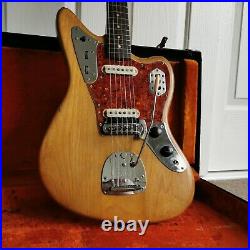
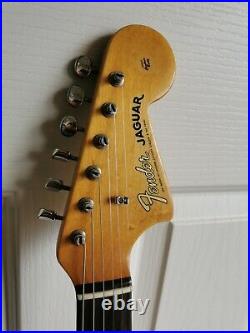
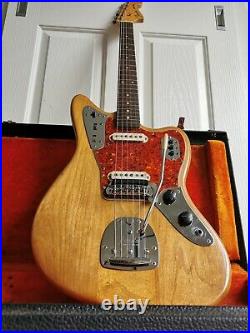
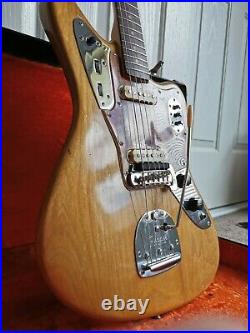
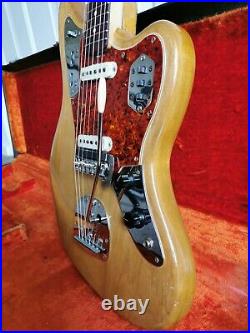
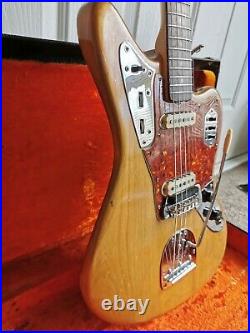
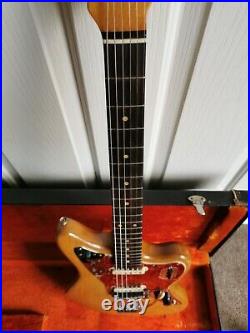
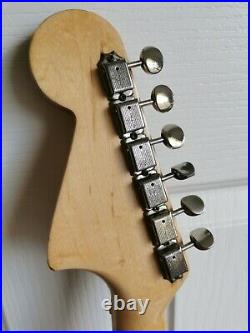
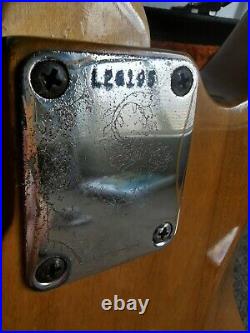
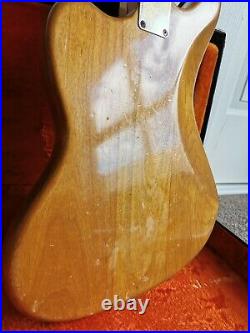
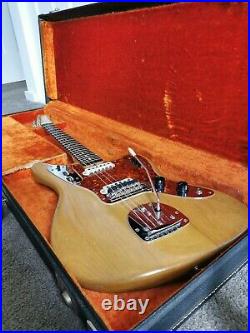
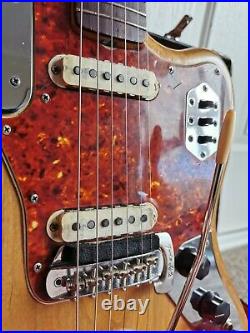

View all 30 pictures at jhguitars. This Pre-CBS instrument has serious personality, and it has the mojo to back it up. It has been stripped and clear coated and it features a groovy engraving on the neck plate. All original electronics to give it THE Jaguar sound. The fretboard is the elusive Brazilian Rosewood we all know and love and the discoloured clay dot fret markers that really always catch my eye. Store it all safely in the original case and enjoy that vintage aroma each time you open it. For any other pictures that you may like, let me know and I will provide them. Neck Date: NOV 1963 B Serial Number: L26195 (1962 – 1963) Pots: 6336 (36th Week of 1963). What makes it special. It’s a unique instrument due to the finish and personal art on the neck plate. That worn-in “plays like butter” neck that only a vintage instrument played for decades can offer. The rhythm circuit wheels are a bit stiff, but function perfectly. The hardware has been polished and cleaned, but still shows scratches and wear. One of the case latches does not spring open. Someone has added a logo to the case (in the wrong spot, by the way). A’63 would not have the logo on the case, but someone thought it needed one anyway! The body and neck have some dings, please see the pictures. The pickguard has the inevitable “shrinkage”. What’s known to be non-original? The body finish. Refinished in the early 70’s. Tremolo Arm and Tip. Logo added to hard case. Please be aware of any import restrictions and costs in your country as this is your responsibility. Fender introduced the JAG in 1962 as the fourth and last instrument in its original standard guitar lineup. Preceded by (1951), (1954) and (1958), the Jaguar was the only one of Fenders big-four guitars born in the 1960s, and it was in several ways the most distinctive among them. Introduced as Fender’s high-end model, the Jaguar was initially adopted by surf guitarists just as that fad was running out of wave. Jaguars everywhere began collecting dust until the punk explosion of the’70s and its subsequent mutations took it from relic to iconic. THE GUITAR The Jaguar had 22 frets and a significantly shorter 24-inch scale length, which was deliberately closer to the standard Gibson scale length of 24.75-inches rather than the standard 25.5-inch Fender scale length of the 21-fret Telecaster, Stratocaster and Jazzmaster. The Jaguars shorter scale and extra fret made for what Fender billed as faster, more comfortable playing. Its relatively smaller size notwithstanding, the Jaguar was indeed billed as Fenders new top-line guitar and was nothing if not feature laden. It had an offset bodydistinct from the Jazzmasters offset shapeand featured separate bridge and floating vibrato units. And if the Jaguars distinctive shorter scale length and extra fret werent all that obvious on first glance, the sheer amount of chrome and controls were. The Jaguar had the most elaborate circuitry of any Fender instrument. Although it and the Jazzmaster were dual-circuit guitars (lead and rhythm), the Jaguars lead circuit was more complex, with three slide switches on a chrome plate on the lower horn (compared to the Jazzmasters single toggle switch). The Jaguar had tall, narrow, high-output pickups that were surrounded by notched metal rings (claws) that reduced hum and concentrated the magnetic field beneath the strings, an unusual feature not found on any other Fender instrument except 1961s Bass VI. The Jaguar was also the first Fender guitar to be offered with a variety of neck widths. Four options were designated A, B, C and D from narrowest to wideststandard, slightly narrower than standard, and two wider than standard. These options were also made available on the Stratocaster and Jazzmaster from 1962 on. Finally, the introduction of the Jaguar marked the first appearance of a new Fender headstock logo known as the transition logo, so named because it bridged the gap between the the companys original spaghetti logo and the heavy black logo adopted at the end of the 1960s. Too many to mention, but here are some highlights. John Frusciante (Red Hot Chili Peppers). Thurston Moore (Sonic Youth). John Squire (Stone Roses). Kevin Shields and Bilinda Butcher (My Bloody Valentine). Billy Corgan (Smashing Pumpkins). Ira Kaplan (Yo La Tengo). Johnny Marr (Smiths, The The, Modest Mouse). Will Sergeant (Echo & the Bunnymen). Blixa Bargeld (Einstürzende Neubauten, Nick Cave and the Bad Seeds). James Johnston (Gallon Drunk, Nick Cave and the Bad Seeds). Troy Van Leeuwen (A Perfect Circle, Queens of the Stone Age). Win Butler (Arcade Fire). Bradford Cox and Lockett Pundt (Deerhunter). The Telecaster and the Stratocaster both were unqualified and ubiquitous successes by 1962, and the Jazzmaster had by then embarked on its own unusual odyssey quite apart from its original intended role as Fenders top guitar. More than the first two guitars, in fact, the Jaguar owed much to the Jazzmaster, which, despite lofty expectations, was immediately dismissed by the East Coast hollow-body jazz cats Fender aimed it at, only to find itself early in the next decade the darling of West Coast surf and instrumental rock groups whose reverb-drenched hits crested the charts between Kennedys election and the arrival of the British. Fender had also spent the 1950s playing David to Gibsons Goliath in a remarkable game of design one-upmanship that gave the world several of its most enduringly acclaimed and successful electric guitar models. And the new top-line guitar model that Fender was preparing to unveil in 1962 included a major design departure specifically intended to appeal to Gibson playersa short scale. With hindsight it might seem curious that early-60s Fender clung so tenaciously to the idea of a feature-laden high-end guitar. It had already scored its greatest successes with four innovative workhorse instruments (two guitars and two basses) remarkable for being elegantly and ingeniously simple rather than complex. Even so, Fender seemed convinced at the time that a more elaborate guitar design was the way forward in a bold new decade when incredible technological advances seemed like daily occurrences. And the Jaguar was nothing if not feature laden. A beautiful guitar, it had a Jazzmaster-like offset body (the two werent identicalthe Jaguars upper horn was and still is sharper than the Jazzmasters), and like the Jazzmaster it had separate bridge and floating vibrato units. Gazing directly at it almost required sunglasses. And the Jaguar eclipsed even the Jazzmaster in number of onboard controls; the former with eight (four switches, two knobs and two inset wheels) compared to the latters six (two switches, two knobs and two inset wheels). The Jaguar also had significantly different pickups than the Jazzmaster, which had big, wide single-coil pickups that sounded smooth and thick but were also highly susceptible to unwanted electrical hum because they were unshielded. The Jaguar had taller, narrower Strat-like high-output pickups that sounded much hotter. Further, Jaguar pickups were surrounded by notched metal rings (claws) that reduced hum and concentrated the magnetic field beneath the strings, an unusual feature not found on any other Fender instrument except 1961s Bass VI. With more controls than any other Fender instrument, the Jaguar had the most elaborate circuitry of any Fender instrument. In designing the Jaguar, Fender still clung to onboard string-muting mechanisms, as found on earlier instruments such as the Jazz Bass (1960) and Bass VI. The spring-operated mute on the Jaguars bridge was nonetheless largely ignored, as most guitarists favored manual muting techniques. Finally, the introduction of the Jaguar marked the first appearance of a new Fender headstock logo. Fender used its original thin spaghetti logo throughout the 1950s until Robert Perine, the adman who created Fenders stylish late-50s and 1960s advertising look (including the famous You wont part with yours either campaign), designed a thicker version of it eventually known as the transition logo, so named because it bridged the gap between the spaghetti logo and the heavy black logo adopted at the end of the 1960s. Perines new Fender logo began appearing in print ads around 1960, and Fender eventually adopted it as a headstock logostarting with the Jaguar. The Jaguar enjoyed mild popularity on its introductionBeach Boy Carl Wilson occasionally played one during the mid-60s, and Jimi Hendrix received a 63 model as a gift from Rolling Stones guitarist Brian Jones. Several other lesser-known guitarists favored the Jaguar during the models first years, including Eddie Bertrand, Dave Myers, Mary Kaye, Kathy Marshall, Paul Guma, Roy Lanham and Bye Bye Birdie star Jesse Pearson, who played a custom black Jaguar with gold-plated hardware and a gold-leaf scroll design on the body. The item “Fender Jaguar 1963 OHSC PRE-CBS Vintage Natural 60’s USA original offset pre cbs” is in sale since Saturday, November 14, 2020. This item is in the category “Musical Instruments\Guitars & Basses\Electric Guitars”. The seller is “jhguitarstasmania” and is located in Longford, TAS. This item can be shipped worldwide.
- Series: Fender Jaguar
- Type: Electric Guitar
- Brand: Fender
